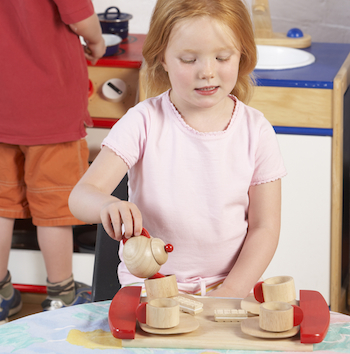Pretend Play to Stimulate Language

Using pretend play to stimulate language and introduce vocabulary is a great way to make learning fun and a little easier. It is also a great opportunity to extend the time your child needs to learn certain phrases with repetition.
Pretend play doesn’t require much expense either – get out the plastic picnic set or use their toys as extra guests. Using boxes for doll’s cribs or creating doll’s houses is also a very good language activity in itself that helps build creativity in your child. These type of open ended activities can stimulate natural conversation through a child’s curiosity and motivation to construct.
Here’s 10 tips to make the most of pretend play and turning daily routine events into role playing moments:
1. Observe your child playing first: watch what they do and how you might be able to incorporate simple language within already routine playtime.
 2. Provide your child with related role playing items: spoons, plates, cups, tea towel, empty tube of toothpaste and toothbrush, cars. They may need guidance to play with them at first but soon they will learn to blend the items to come up with their own games.
2. Provide your child with related role playing items: spoons, plates, cups, tea towel, empty tube of toothpaste and toothbrush, cars. They may need guidance to play with them at first but soon they will learn to blend the items to come up with their own games.
3. Once your child is confident in role playing you can add more items to increase the details of the game – introducing more vocabulary and association the language with the items they already know eg cup and saucer, fork and spoon.
4. This is also a great time to encourage them to take the lead and ‘tell you’ what role you are within the game because they have become confident in ‘pretending’. This means you are playing alongside them, and your child is having fun while learning.
5. To remove yourself and increase their independence and repetition, set up extra toys like the teddy bears and dolls for tea parties or different roles such as patients or brothers and sisters when role playing.
6. Turn regular bath time into learning time by giving your child a doll to wash while you wash them. This will help them learn verbs such as wash, scrub, rub, dry and identify related body parts.
7. Collect various baby clothes from garage sales or the second hand store to provide your child for dressing a doll or teddy bear. Not only this a great way for them to learn the vocabulary of clothing but phrases such as zip it up, unbutton, undress, bedtime, bathtime.
8. A toy telephone set is an excellent way to teach social skills and practise listening and comprehension skills. If you have a set of walkie talkies then why not take advantage of them and role play over real events!
 9. Using a doll’s house is the perfect way to start increasing the language of furniture and household items. Rahter than leaving a doll’s house set up for next time – always pack away the items into a container so that your child can practise room associations with the furniture. This is a great way to stimulate conversations around the items your child tends to forget.
9. Using a doll’s house is the perfect way to start increasing the language of furniture and household items. Rahter than leaving a doll’s house set up for next time – always pack away the items into a container so that your child can practise room associations with the furniture. This is a great way to stimulate conversations around the items your child tends to forget.
10. Some of the favourite bedtime stories can turn into pretend play too. Have your child choose to read a favourite book to their teddies or you. The best books to increase independence are finding books that have repeated sentences and lots of pictures to help cur your child to retell the story in their own words.
What is most important when using pretend play to stimulate language is to go slow. Build the role playing into what are already routines and then extend and increase independence at your own child’s pace. Pretend play is also a great way to involve siblings – a lot of the time they cannot get involved with their brother or sister’s special needs learning – but they can be the best motivating role models when it comes to pretend play.
And lastly – have fun, make it silly sometimes and laugh with your child – this in itself is a great way to bond with your child and they will see the activities as fun times with you and not as language lesson times.
If you liked these ideas you might want to read about how you can use Puppet Play to develop language as well!

 Cart (0)
Cart (0)







